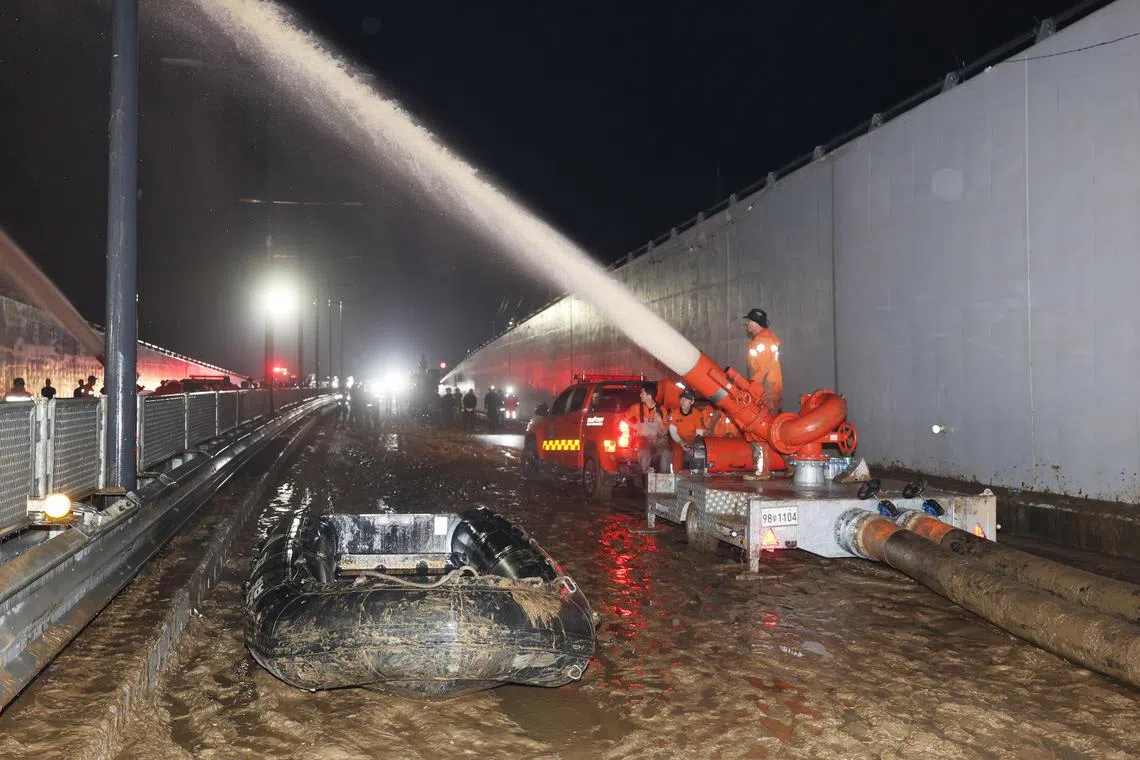South Korea’s Yoon vows ‘complete overhaul’ of approach to extreme weather after rains kill 40
Sign up now: Get insights on Asia's fast-moving developments

Rescue workers pumping water out of a flooded underground tunnel in the town of Osong, in North Chungcheong province, on July 17.
PHOTO: EPA-EFE
Follow topic:
SEOUL - South Korea’s President Yoon Suk-yeol vowed on Monday to “completely overhaul” the country’s approach to extreme weather from climate change, after at least 40 people were killed by recent flooding and landslides during monsoon rains.
He also blamed the authorities’ failure to follow disaster response rules, as he noted that more rain is forecast in the coming days.
“This kind of extreme weather event will become commonplace – we must accept climate change is happening, and deal with it,” Mr Yoon said during an emergency response meeting on Monday.
The idea that extreme weather linked to climate change “is an anomaly and can’t be helped needs to be completely overhauled”, he said, calling for “extraordinary determination” to improve the country’s preparedness and response.
South Korea will “mobilise all available resources” including the military and police to help with rescue efforts, he said.
“The rainy season is not over yet, and the forecast is now that there will be torrential rain again tomorrow,” he added.
Following the meeting, Mr Yoon, who returned from an overseas trip early on Monday, travelled to Yecheon in North Gyeongsang province – one of the hardest-hit villages, where more than a third of houses were damaged in landslides and two people remain missing.
Dressed in a green jacket, often donned by top officials during public emergencies, Mr Yoon was briefed by officials as he walked past piles of fallen trees and relief workers shovelling mud.
“I’ve never seen something like this in my life, hundreds of tonnes of rocks rolling down from the mountain,” Mr Yoon said, telling the villagers: “I’ll do everything I can to restore the village.”
The majority of the casualties – including 19 of the dead and eight of the missing – were from North Gyeongsang province, where massive landslides in the mountainous area engulfed houses with people inside.
South Korea is at the peak of its summer monsoon season, and days of torrential rain
On Monday, the South Korean government and police launched separate inquiries into the fatal flooding of an underpass in the city of Cheongju, which is around 112km south of Seoul.
It became flooded early on Saturday morning when a nearby river overflowed and an embankment collapsed, trapping more than 10 vehicles, including a bus.
At least 13 people were killed, and rescue workers have warned the toll could rise as they search the area.
The Prime Minister’s Secretariat said there had been reports of calls to police requesting an emergency evacuation order for nearby residents as well as emergency closure of the tunnel an hour before the disaster struck.
“This investigation is to find out the cause of the failure to protect the precious life of the people,” it said in a statement.
The incident fuelled questions over South Korea’s efforts to prevent and respond to flood damage.
Some drivers who use the road regularly blamed the government for failing to ban access to the underpass even though floods were widely forecast.
Floods have claimed dozens of lives during recent rainy seasons as weather patterns have become more extreme.
The government in 2022 vowed to take steps to better cope with climate change-induced disasters after the heaviest downpours in 115 years pounded Seoul, including the glitzy district of Gangnam, leaving at least 14 dead and flooding subways, roads and homes. AFP, REUTERS

